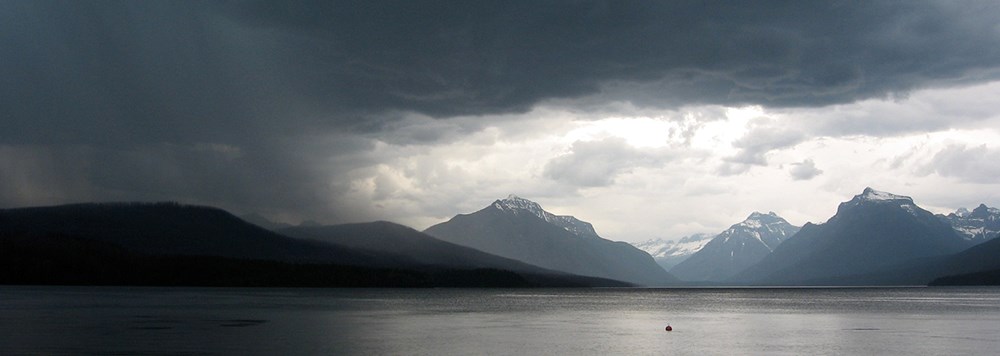
NPS Glacier's weather is highly variable and can be extreme. Hikers setting out on a warm summer day, if they are careful, bring along raingear and lots of extra clothing. Just outside the park's eastern boundary, in Browning, Montana in 1916, the temperature dropped from 46 degrees F to –56 degrees in 24 hours—that's 100 degrees in a day! It is still an all-time world record. (That's 8 degrees C to -49 degrees C.) Glacier's geography, straddling the Continental Divide, sets the stage for clashes of two very different climates. Warm, wet Pacific air moves in from the west, and cold dry Arctic air from the northeast. They meet at the Divide. Precipitation The east side of Glacier is in a rain shadow and gets less overall precipitation than the west. The dryness of the east side is also due to high winds. Downslope winds are often 50 mph or more, sometimes reaching 100 mph. Warm chinook ("snow-eater") winter winds regularly create a temporary spring, raising temperatures over 30 degrees in just minutes. If the cold Arctic air pools deep enough on the east side, spills over the top, and collides with Pacific moisture, raging blizzards can result. One dumped 44 inches (112 cm) of snow in a day. Climate Change Glacier scientists and partners are doing landmark research on the effects of global climate change in this mountain ecosystem. Recent warming trends have accelerated the shrinking of glaciers in the park. Warmer and more variable winter and spring air temperatures have caused more precipitation to fall as rain rather than snow and has led to earlier snowmelt. As this trend continues, loss of winter snowpack and glacial loss will greatly reduce the major source of groundwater recharge and summer runoff, resulting in a lowering of water levels in streams, rivers, lakes, and wetlands during the growing season. As water levels are lowered, the amount of habitat in streams for invertebrates and fish will be reduced, and lower groundwater tables will alter the riparian vegetation communities. Without glacial melt water, summer water temperatures will rise and may cause the local extinction of temperature sensitive aquatic species. These alterations in temperature could lead to a disruption of the aquatic food chain, which may impact keystone aquatic species such as the native bull trout. |
Last updated: August 5, 2016
